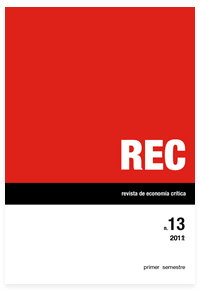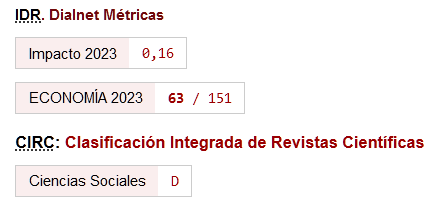Comentario a: Where have all the Sraffians gone? – They are still blooming
Keywords:
Sraffian economics, Heterodox economistsAbstract
The aim of this article is to argue that the Sraffian paradigm is still alive and may be the basis of an alternative to the marginalist research program, contrary to the presentation in Garrido de la Morena (2010) article, “Where have all the Sraffians gone?”. The author is right to point out the worrying invisibility of this economic approach in academia. Yet, this situation should be analyzed as an offshoot of the cultural hegemony of neoliberalism, and not of the intellectual underdevelopment of the Sraffian current or the disputes of its members.
Downloads
References
Aspromourgos, T. (2004) "Sraffian Research Programmes and Unorthodox Economics" Review of Political Economy, 16(2), pp.179-206.
https://doi.org/10.1080/0953825042000183181
Barba, A. (2001) "Rethinking expansionary fiscal retrenchments", Contributions to Political Economy, 20, pp. 57-86. https://doi.org/10.1093/cpe/20.1.57
Barba, A.; Pivetti, M. (2009) "Rising household debt: Its causes and macroeconomic implications-a long-period analysis" Cambridge Journal of Economics, 33 (1), pp. 113-137. https://doi.org/10.1093/cje/ben030
Bowles, S.; Gintis, H. (2007). Power. WP 2007-03, Department of Economics, University of Massachusetts-Amherst, mimeo. Disponible on-line: http://www.umass.edu/economics/publications/2007-03.pdf
Cesaratto, S. (2005) Pension Reform and Economic Theory: a non-orthodox analysis. Aldershot: Edward Elgar. https://doi.org/10.4337/9781781007457
Cesaratto, S.; Serrano, F.; Stirati, A. (2003) "Technical Change, Effective Demand and Employment" Review of Political Economy, 15(1), pp. 33-52. https://doi.org/10.1080/09538250308444
Eatwell, J.; Taylor, L. (2001) Global Finance at Risk: The Case for International Regulation. The New Press.
Eatwell, J.; Taylor, L. (2004) International Capital Markets: Systems in Transition. New York: Oxford University Press.
Febrero, E. (2008). "The Monetization of Profits in a Monetary Circuit Framework". Review of Political Economy, 20(1), pp.111-125.
https://doi.org/10.1080/09538250701662002
Garegnani, P. (1976). "On a Change in the Notion of Equilibrium in Recent Work on Value and Distribution" en: Eatwell y Milgate (1983) Keynes' Economics and the Theory of Value and Distribution. New York: Oxford University Press.
Garegnani, P. (1978): "Sraffa's revival of Marxian economic theory". New Left Review. I/112.
Garegnani, P. (1989) "On Sraffa's Contribution to Economic Theory", en Feiwel G.R. (1989). Joan Robinson and Modern Economic Theory. Palgrave-Macmillan. https://doi.org/10.1007/978-1-349-08633-7_13
Garegnani, P. (1992) "Some notes for an analysis of accumulation", en: Halevi Halevi, J.; Laibman, D.; Nell, E.J. eds. (1992) Beyond the Steady State: a Revival of Growth Theory New York: St Martin's Press.
Garegnani, P. (2005a) "On a turning point in Sraffa's theoretical and interpretative position in the late 1920s". European Journal of the History of Economic Thought, 12(3), pp. 453-492. https://doi.org/10.1080/09672560500240099
Garegnani, P. (2005b) "Capital and Intertemporal Equilibria: A Reply to Mandler". Metroeconomica. 56(4), pp. 411-437. https://doi.org/10.1111/j.1467-999X.2005.00223.x
Garegnani, P. (2007a). "Professor Foley and Classical Policy Analysis". Review of Political Economy. 19(2), pp. 221-242. https://doi.org/10.1080/09538250701256805
Garegnani, P. (2007b). "Professor Samuelson on Sraffa and the classical economists" European Journal of the History of Economic Thought. 14(2), pp. 181-242. https://doi.org/10.1080/09672560701327919
Garrido de la Morena, A. (2010) "Where have all the Sraffians gone? (A propósito del cincuentenario de Producción de mercancías por medio de mercancías)" Revista de Economía Crítica 10, pp. 198-210.
Han, Z.; Schefold, B. (2006) "An Empirical Investigation of Paradoxes: Reswitching and Reverse Capital Deepening in Capital Theory" Cambridge Journal of Economics 30(5), pp. 737-765. https://doi.org/10.1093/cje/bei089
Kurz, H. (1992). "Accumulation, Effective Demand and Income Distribution", en: Halevi, J.; Laibman, D.; Nell, E.J. eds. (1992) Beyond the Steady State: a Revival of Growth Theory New York: St Martin's Press. https://doi.org/10.1007/978-1-349-10950-0_4
Kurz, H.; Salvadori, N. (1996). Theory of Production: A Long-Period Analysis. Cambridge University Press. https://doi.org/10.1017/CBO9780511625770
Kurz, H.; Salvadori, N. (2010). In Favor of Rigor and Relevance. A Reply to Mark Blaug. MPRA Paper No. 20530, mimeo. Disponible en línea: http://mpra.ub.uni-muenchen.de/20530/
Lavoie, M. (1992a) Foundations of Post-Keynesian Economic Analysis. Aldershot: Edward Elgar.
Lavoie, M. (1992b) "Towards a new research programme for Post-Keynesianism and neo-Ricardianism", Review of Political Economy, 4, pp. 37-78. https://doi.org/10.1080/09538259200000003
Lavoie, M. (2006) "Do Heterodox Theories Have Anything in Common? A Post-Keynesian Point of View" Intervention, 3 (1), pp. 87-112.
https://doi.org/10.4337/ejeep.2006.01.08
Levrero S.; Stirati A. (2006) "The Influence of Unemployment, Productivity and Institutions on Real Wage Trends: The Case of Italy 1970-2000", en: Hein, E.; Heise, A.; Truger, A. (eds) (2006) Wages Employment and Growth - International Perspectives, Palgrave-Macmillan.
https://doi.org/10.1057/9780230371781_6
Nell, E. J. (2004) Monetizing the Classical Equations: a theory of circulation, Cambridge Journal of Economics, 28, pp. 173-203.
https://doi.org/10.1093/cje/28.2.173
Nell, E.J. (1998) The General Theory of Transformational Growth: Keynes After Sraffa, Cambridge: Cambridge University Press.
https://doi.org/10.1017/CBO9780511571794
Palumbo, A. and Trezzini, A. (2003) 'Growth without normal utilization', European Journal of the History of Economic Thought, 10 (1), pp. 109-135. https://doi.org/10.1080/0967256032000043814
Panico, C. (1997) "Government deficits in Post-Keynesian theories of growth and distribution", Contributions to Political Economy, 16, pp. 61-86. https://doi.org/10.1093/oxfordjournals.cpe.a014057
Park, M.S. (2004) "Credit money and "Kaldor's" institutional theory of income distribution" Review of Political Economy, 16(1), pp.79-99.
https://doi.org/10.1080/0953825032000145472
Park, M.S. (2006) "The financial system and the Pasinetti theorem" Cambridge Journal of Economics, 30(2), pp. 201-217.
https://doi.org/10.1093/cje/bei056
Pasinetti, L. L. (1993) Structural Economic Dynamics: a Theory of the Economic Consequences of Human Learning. Cambridge: Cambridge University Press.
Pivetti, M. (1991) An Essay on Money and Distribution. St Martin's Press, New York. https://doi.org/10.1007/978-1-349-21334-4
Pivetti, M. (2001) "Money endogeneity and monetary non-neutrality: a Sraffian perspective", en: Rochon y Vernengo (2001). Credit, Interest Rates and the Open Economy: Essays on Horizontalism. Edward Elgar. https://doi.org/10.4337/9781782542827.00015
Pivetti, M. (2007). "Distribution, Inflation and Policy Analysis". Review of Political Economy, 19(2), pp. 243-247. https://doi.org/10.1080/09538250701256813
Roncaglia, A. (1978) Sraffa and the Theory of Prices. New York: Wiley.
Roncaglia, A. (1990): Las Escuelas Sraffianas, Cuadernos de Economía Aplicada, Madrid.
Roncaglia, A. (2003) "Energy and Market Power: An Alternative Approach to the Economics of Oil". Journal of Post Keynesian Economics. 25(4), pp. 641-659.
Serrano, F. (1995) "Long period effective demand and the Sraffian supermultiplier", Contributions to Political Economy, 14, pp. 67-90.
https://doi.org/10.1093/oxfordjournals.cpe.a035642
Skott, P. (2010) 'Growth, instability and cycles: Harrodian and Kaleckian models of accumulation and income distribution', en: Setterfield, M. (ed.), Handbook of Alternative Theories of Economic Growth, Cheltenham: Edward Elgar. https://doi.org/10.4337/9781849805582.00011
Sraffa, P. (1960). Production of Commodities by Means of Commodities. Cambridge: Cambridge University Press.
Steedman, I. (1999) "Production of Commodities by Means of Commodities and the open economy", Metroeconomica, 50, pp. 260-276.
https://doi.org/10.1111/1467-999X.00073
Steedman, I. (2004). "Vertical Integration in the Changing Economy". En: Arena y Salvadori (2004). Money, credit, and the role of the State: Essays in honour of Augusto Graziani. Ashgate; Aldershot.
Steedman, I. (ed.) (2001) "Exhaustible natural resources and Sraffian analysis: a symposium", Metroeconomica, 52, pp. 239-328.
https://doi.org/10.1111/1467-999X.00116
Stirati, A. (2001) "Inflation, Unemployment and Hysteresis: An alternative view," Review of Political Economy, vol. 13(4), pp. 427-451.
https://doi.org/10.1080/09538250120099944
Sylos Labini, P. (1993) Economic Growth and Business Cycles. Edward Elgar.
Sylos Labini, P. (2001) Underdevelopment: a strategy for reform. Cambridge University Press.
Downloads
Published
How to Cite
Issue
Section
License
This licence allows third parties to share (copy and redistribute the material in any medium or format) and adapt (remix, transform and create from the material for any purpose, including commercial purposes), provided that authorship and first publication in this journal (The Journal, DOI of the work) is acknowledged, a link to the licence is provided, and it is stated whether changes have been made to the work.







